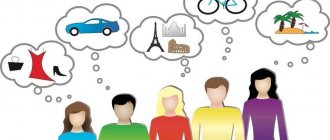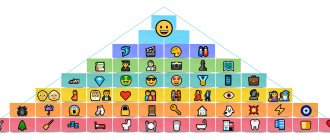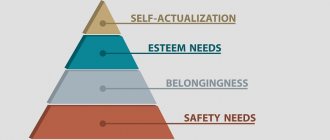In this article we will tell you:
- Concept of human needs
- Scientific theories about human needs
- The order of formation of human needs
- Differences between needs and wants
- Specifics of meeting human needs
Human needs are varied and difficult to classify. However, scientists have proposed several methods for grouping and evaluating them. There are several popular theories on this matter.
At first glance, it may seem that needs are a natural part of our lives and we ourselves know our needs best. This is partly true, but understanding how they are formed, what ways exist to satisfy them, and what is the difference between needs and “wants” will help to improve your life qualitatively.
In our article we will tell you what the nature of human desires is, what they are, and also how they can be closed.
Manifestation of need
The need is manifested in the selective attitude of the individual to the existing conditions of the external world and is a dynamic and cyclical quantity. Primary needs relate to biological needs; in addition, a person feels the need to stay in society. The peculiarity of the need is such that it is an internal motivation and stimulus for activity, but at the same time work becomes a subject of necessity.
At the same time, doing something creates new needs, since certain funds and costs are needed to bring the plan to life.
What alternatives to Maslow's pyramid exist today?
Before we begin a detailed study of the hierarchy of needs according to Maslow’s pyramid, it is worth saying that there are other approaches to assessing human behavior and the incentives that force him to be active. Here are just a few of them:
- Alderfer's theory. It is based on Maslow’s pyramid, but tries to make the system more generalized and simpler, reducing all human needs to the following: the need to exist, the need for connections with others, the need for constant growth;
- McClelland's theory. This researcher believed that in the hierarchy of human needs, only the highest motives are the most important: the desire for power, success, involvement in great deeds and achievements;
- Herzberg's theory. A more applied theory, which is aimed at analyzing people working in a business. Shows that the higher the motivation of employees, the more non-standard tasks they solve, the more responsibility they have for their work, and the more they receive decent remuneration. Otherwise, motivation deteriorates sharply.
There are other theories, but we will look at the 5 steps of Maslow’s pyramid of needs and try to figure out whether all this works today or not.
Needs in society
A society in which human needs are not developed and reproduced is doomed to degradation. The needs of people in different eras correspond to the spirit of entrepreneurship and development, reflect dissatisfaction and despair, express collectivism, a common faith in future affairs, generalize people's aspirations and claims that need periodic satisfaction. The relationship between primary and secondary needs is formed not only in terms of social status, but under the influence of the accepted lifestyle, the level of spiritual development, and the diversity of social and psychological groups in society.
Without satisfying urgent needs, society cannot exist and reproduce social values at the level of historical and cultural standards. Urgent needs for movement, communication, and possession of information require society to develop transport, means of communication, and educational institutions. People care about satisfying primary and secondary needs.
Differences between needs and wants
Needs and desires are not the same thing. There are differences.
| Needs | Desires |
| 1. Needs are always constructive. Human needs indicate the importance and primacy of their satisfaction for the possibility of further functioning and life. 2. The basis of the need is always something important and deep. 3. Thanks to the satisfaction of needs, a person finds harmony with himself. | 1. They are destructive in nature. May harm personal development and life. So, drug addiction is a “wish”, not a need. 2. Other people can impose “wants.” 3. Desires may be superficial and not satisfy the true needs of a person. |
Let's try to figure it out with an example. Imagine that you live in your own apartment and dream of a summer house. You don't have enough money to buy a summer house, so you're angry. In this case, giving is a desire. But if you have nowhere to live, then buying any housing is satisfying a need.
Why is it necessary to distinguish between needs and desires? This is necessary for proper distribution of energy and resources. It also makes it possible to better understand yourself and others. Well, besides, seeing the differences, a person will be able to set priorities correctly.
To make the task easier, just honestly answer the following questions:
- Is it possible to do without this? A fashionable dress is a desire, but not a need. You can put it aside and buy it when there are enough opportunities for this.
- What will I get? The answer to this question will help you understand the nature of the origin of what you want.
- Will this purchase limit me? Desires should not interfere with the satisfaction of needs. Always prioritize.
Types of needs
Human needs are so diverse that to generalize them into different categories requires classification according to several criteria:
- Primary and secondary needs are divided in importance;
- according to the grouping of subjects, collective, individual, public and group are distinguished;
- according to the choice of direction, they are divided into ethical, material, aesthetic and spiritual;
- if possible, there are ideal and real needs;
- by area of activity, the desire to work, physical rest, communication and economic areas are distinguished;
- According to the method of satisfying needs, they are divided into economic, requiring limited material resources for production, and non-economic (need for air, sun, water).
Application of Maslow's pyramid
Maslow's pyramid can be most successfully applied in certain areas, such as:
- marketing
- life
- work and business
- when building a career
- running a company
Let's expand on each topic a little for a broader understanding.
Application in marketing
Maslow shows human needs in the form of a hierarchy, so marketing companies and marketers can rely on this theory in order to understand exactly how to attract this or that category of people. If it is necessary to motivate, say, employees, then lower incentives such as increasing salaries or reducing working hours work here; management employees are already concerned about other issues: comfort, conditions for career growth, respect from management.
Application in life
The application of this theoretical concept in life is quite limited, but it can be useful for every person. We must not only look at what is at the top of Maslow's pyramid, but also cover basic needs if there are problems there. This will help relieve stress and tension, cope with professional burnout, and open up mental strength for new and greater achievements.
Maslow's pyramid in work and business
In these areas, the use of the theory under consideration comes down to competently stimulating your employees, understanding how to properly influence their performance, attitude towards work and work responsibilities. By managing to some extent the basic needs of people and clients, we can make ourselves more attractive in their eyes and offer solutions to specific pressing problems. After all, a business is more successful the more effectively it solves a client’s problem.
In building a career
In career matters, we should always remember what is at the top of Maslow's pyramid, but not try to jump straight there, since such a “maneuver” is available to very few geniuses. In a career, the pyramid will always help you remember that there are basic things that we cannot turn a blind eye to, so that they do not drag us down and close off the possibility of further growth. For example, if we work in conditions of low wages and cannot provide for our family, we work without respect from colleagues and superiors - this will greatly hinder or even slow down our growth.
In the practice of enterprise management
You can use Maslow's theory in business management. Here, too, everything is simple: each subordinate at his level and the ability to satisfy his needs must be selected with optimal incentives, satisfy these basic needs, or be given a real hope of satisfying them. If you add some qualities to your work that cover higher levels, you can also reduce stress from problems at lower levels. For example, a job where the boss respects and treats his subordinates well will be more interesting to many people than a high salary, but a bad attitude, which can lead to causes of professional burnout.
Primary Needs
This category includes innate physiological needs, without which a person cannot physically exist. These include the desire to eat and drink, the need to breathe clean air, regular sleep, and satisfaction of sexual desires.
Primary needs exist at the genetic level, and secondary needs arise with increasing life experience.
Advantages and disadvantages
Maslow's pyramid is valuable for studying large masses of people when there is no need to look closely at individuality. If we talk about its pros and cons, we can highlight the following:
- Pros. The ability to understand large masses of people, the applicability of theory to work in large teams, the ability to explain the behavior of individual people quite accurately, and have leverage over them. Also, thanks to theory, you can better understand yourself;
- Of the minuses: A. Maslow could not thoroughly describe each individual with his theory, take into account the variability of character, inconstancy, the presence of geniuses, dependencies on certain things. Many people behave differently and do not have the priorities that they should have, if assessed from the point of view of Maslow's theory.
Many psychologists believe that the pyramid is already outdated and today, when most people do not worry about low needs, it does not reflect reality.
Ideal Needs
This group includes the desire to develop independently, manifested in the desire to receive new information, explore it and navigate in society. The need to study the surrounding reality leads to an awareness of one’s place in the modern world, knowledge of the meaning of life leads to an understanding of one’s purpose and existence. Intertwined with the ideal are primary needs and spiritual desires, which represent the desire for creative activity and awareness of beauty.
A satisfied need ceases to motivate
Another interesting phenomenon is that if a need has already been satisfied, it often ceases to motivate a person. Almost all of us know this, but for some reason Maslow did not take this phenomenon into account in his theory. After all, the system of needs is also conditional in the sense that if a person has achieved what he wants, he does not rejoice at it for long, again falls into boredom, despondency, and looks for new supports for further growth.
We know from our own lives that it is enough to buy, study, build something - interest in it immediately disappears, the faster the more lively, active and ambitious the person is. But this is not reflected in Maslow’s pyramid.
Spiritual aspirations
Spiritual interests develop in a person in connection with the desire to enrich life experience, broaden his horizons, and develop creative abilities.
The growth of personal potential forces an individual not only to be interested in the culture of humanity, but also to care about representing the values of his own civilization. Spiritual aspirations presuppose an increase in psychological tension during emotional experiences, awareness of the value of the chosen ideological goal.
A person with spiritual interests improves his skills and strives for high results in the field of activity and creativity. An individual treats work not only as a means of enrichment, but learns his own personality through work. Spiritual, biological and social needs are closely intertwined. Unlike the animal world, in human society the primary need is for biological existence, but it gradually turns into a social one.
The nature of the human personality is multifaceted, hence the variety of types of needs. The manifestation of aspirations in various social and natural conditions makes their classification and division into groups difficult. Many researchers offer various distinctions, putting motivation at the forefront.
Controversial sides of the pyramid and criticism
Psychologists of many directions actively criticize Maslow’s system, finding in it many discrepancies with real life and specific people. Here are the main statements of critics on this issue:
- History knows a lot of cases when the dissatisfaction of basic needs did not make a person more down-to-earth, but, on the contrary, stimulated him to act and create, write songs, develop, comprehend nature and God;
- Each person has their own level of satisfaction with things. One has enough of the meager lunch, another suffers from the inability to eat in the most expensive restaurant in the city;
- The inability to recognize Maslow’s theory as 100% working is also associated with the fact that many people show insatiable aspirations and cannot satisfy the most basic needs, wanting more and more.
Often brilliant people were poor, physically weak, unhappy and despised by society, but this did not prevent them from remaining in history.
Classification of needs of a different order
Primary human needs are divided into:
- physiological, which consists of the existence and reproduction of offspring, food, breathing, shelter, sleep and other needs of the body;
- existential needs, which are the desire to ensure comfort and safety of living, work to obtain benefits, and confidence in future life.
Secondary needs acquired during the course of life are divided into:
- social aspirations to gain connections in society, to have friendly and personal attachments, to take care of relatives, to gain attention, to participate in joint projects and activities;
- prestigious desires (to respect oneself, to gain recognition from others, to achieve success, high awards, to move up the career ladder);
- spiritual - the need to express oneself, to realize one’s creative potential.
Theory and practice
In theory, everything looks quite interesting. Maslow's coherent theory of needs is very logical; it really describes reality and nature well for most people around. But over time, there were many critics of this theory, since in practice it began to increasingly diverge from reality.
The theoretical calculations of A. Maslow began to be actively applied in practice. Here are just a few areas of activity where they were adopted:
- Psychology and sociology. Researchers began to look at society and typical human needs with greater understanding and began to see patterns in all this;
- Maslow's theory is applied in human resource management systems to increase employee motivation and increase their ability to work and efficiency;
- There are many tips on how you can use Maslow’s pyramid in marketing, where it allows you to attract attention and encourage people to make purchases and orders.
Also, the theory continues to interest theoretical researchers who are trying to clarify and supplement it to this day.
Classification of desires according to A. Maslow
If you find out that a person has a need for shelter, food and a healthy lifestyle, then you have identified a primary need. Need forces an individual to strive to obtain essential benefits or change an undesirable situation (disrespect, shame, loneliness, danger). The need is expressed in motivation, which, depending on the level of personal development, takes on a specific and definite form.
Primary needs include physiological needs, for example, procreation, the desire to drink water, breathe, etc. A person wants to protect himself and his loved ones from enemies, help them treat diseases, and protect them from poverty. The desire to get into a certain social group sends the researcher to another category - social needs. In addition to these aspirations, the individual feels a desire to be liked by others and demands respectful treatment.
Human needs are constantly changing; in the process of human evolution, motivation is gradually being revised. E. Engel's law states that the demand for low-quality food products decreases as income increases. At the same time, the demand for food products, which are required of increased quality while improving the standard of human life, is increasing.
What is the meaning of Maslow's pyramid
If Maslow’s pyramid is considered, the human needs in it are stated rather conditionally, vaguely, the theory is sometimes far from practice. But it has a meaning and it is quite simple - looking at the picture of the pyramid, we must understand that a person is a complex being and there are things that concern him first, and there are things that can be put off until later.
By understanding what motivates people, you can effectively build communication and work process with them, find the right incentives for collaboration and increase the efficiency of employees.
Motive of behavior
The existence of needs is judged by a person’s deeds and behavior. Needs and aspirations are referred to as quantities that cannot be directly measured and observed. Researchers in the field of psychology have determined that certain needs motivate an individual to act. The feeling of need forces a person to act to satisfy needs.
Drive is defined as a lack of something that turns into a certain course of action and a person concentrates on achieving the result. The result in its final manifestation means a means to satisfy desire. If you achieve a certain goal, it may mean complete satisfaction, partial or incomplete. Then determine the ratio of primary and secondary needs and try to change the direction of the search, while leaving the motivation the same.
The amount of satisfaction obtained as a result of an activity leaves a mark on memory and determines the behavior of the individual in the future under similar circumstances. A person repeats those actions that caused the satisfaction of primary needs, and does not commit actions leading to failure to fulfill his plans. This law is called the law of result.
Managers in modern society model situations that allow people to feel satisfaction through behavior that benefits them. For example, a person in the process of production activity must imagine the completion of work in the form of a meaningful result. If the technological process is structured in such a way that the individual does not see the final result of the work, this will lead to the disappearance of interest in the activity, violation of discipline and absenteeism. This rule requires the administration to develop the production sector in such a way that technology does not conflict with human needs.
PRIMARY NEEDS are physiological in nature and, as a rule, innate.
Examples include the need for food, water, breathing, sleeping and sexual needs. SECONDARY NEEDS are psychological in nature. For example, the needs for success, respect, affection, power and the need to belong to someone or something. Primary needs are genetically determined, while secondary needs are usually recognized through experience. Because people have different backgrounds, people's secondary needs vary more than their primary needs. [p.363] Needs are the conscious absence of something that causes an urge to action. Primary needs are genetically laid down, and secondary needs are developed in the course of cognition and gaining life experience. [p.384]
National food security is an important component of national-state security and, as such, characterizes the economic stability and political independence of the existing system, its ability to provide the basic, primary needs of its citizens without compromising national-state interests. Therefore, the concept of food security has two aspects. [p.87]
In addition, social protection of vulnerable segments of the population is considered from the point of view of satisfying primary needs (according to A. Maslow), and social protection of university employees is considered not only primary, but also secondary, more essential needs. “They work not just for a paycheck, but to serve the highest national interests. Money, prestige, comfort are not the main thing for such people. And there are many such workers, which is confirmed by research data. For many employees, values such as respect for people (92.4%), creative work and self-realization of abilities (87.3%), reputation (64.4%) are of priority importance” [29]. [p.343]
In Fig. Figure 18 shows hypothetical curves of need and demand for a certain product. In the first part of the graph, up to the point (k, the need exceeds the demand - the principle of the primacy of need is triggered. This is also explained by the following factors [p.132]
Primary needs are often satisfied with money. But money motivates action (according to Western experts) only 30-50% of work [p.119]
Motivation is of great importance for workers engaged in scientific activities. In this regard, an important role is played by the classification and analysis of motivating factors, as well as the study of individual behavior as a function of his perceptions and expectations associated with a given situation. It should be borne in mind that, along with the primary needs that are satisfied with the help of money, there are more elevated needs - for knowledge, authority, creativity. Moral ideals, great goals, moral beliefs, habits, traditions, etc. are often of decisive importance to scientists. [p.140]
Having studied the market and settled on any specific suppliers, the purchasing department is obliged to determine the needs of the enterprise or firm for specific supplies. Determining needs is based on an inventory management strategy, which is covered in a special section in the textbook. In this chapter we outline only the basic principles for determining needs. First of all, identifying needs means identifying goods and services based on their quality, quantity, mainly in two methods by determining needs based on orders and systematically determining needs based on expenses. Determination of requirements based on orders, for example in mechanical engineering, occurs by decomposing specifications into individual components, taking into account existing stocks. The primary needs here are the needs for finished products, the secondary needs are for the units from which the products are assembled, and the tertiary needs are for the parts that make up the units. The timing of meeting subsequent needs is determined based on the timing of the previous purchases. [p.95]
Needs are classified according to certain criteria. Thus, a distinction is made between primary and secondary needs. Primary needs are those needs that a person experiences in any situation because their satisfaction is vital (for example, food, water, clothing, etc.). Secondary needs are those that arise with the development of civilization (for example, refrigerators, televisions, cars). In addition, a distinction is made between individual and social needs. Individual are those needs that a person experiences as an individual. People feel social needs as members of society. For example, food and water are individual needs, while the needs are for social order, justice, etc. —- social. Typically, a person himself ensures that his individual needs are met by buying, for example, food and clothing from other people. At the same time, the government or other public organizations (parliament, city council, etc.) ensure satisfaction of the public [p.52]
American researcher A. Maslow divided the entire set of needs into two groups: primary and secondary needs. In turn, Maslow divided the primary needs into physiological, the need for safety and security. [p.65]
There are also natural (objective) and artificial (subjective) conflicts. Natural conflicts arise as a result of a spontaneous combination of circumstances, aggravation of relations between groups of people regarding the satisfaction of their primary needs; artificial conflicts are created by people to achieve certain goals. [p.125]
Primary needs are physiological in nature and, as a rule, innate. These include the needs to breathe, sleep, eat, and sexual needs. [p.112]
Because of this, primary needs are genetically determined, and secondary needs are usually recognized through experience. Needs cannot be directly observed and measured. Needs serve only as a motive for action. They can be judged by people's behavior. When a need is felt by a person, it induces a state of aspiration in him. [p.113]
Maslow arranged all these needs in the form of a strict hierarchical structure (pyramid). In this case, the needs of the first and second levels are classified as primary needs, and the subsequent ones (third - fifth level) are classified as secondary needs. Maslow's hierarchy of needs is shown in Fig. 4.9. [p.115]
There are also primary and derived needs. In the classical school, primary needs are called needs, and derivatives are called needs. [p.32]
Primary needs are innate in nature, they are genetically determined. These are the needs for food, water, the need to breathe, sleep, the need for communication. [p.211]
Feelings are a form of consumers’ representation of their incentives for behavior in the market, a form of their awareness of their primary needs. It is important to note that the true feelings of people (and many organizations) do not depend on them and are not under their control. Sensations are in all cases something derivative, secondary from stimuli and are determined only by them. For example, a person in a supermarket cannot control his visual reaction to the display of goods, their packaging, etc., since the general visual perception of objects does not depend on the person (unless he is blind, of course) (he sees as many products as are located nearby ). [p.209]
Requests and preferences are a set of options for satisfying primary needs that arise in the consumer under the influence of sensations. The consumer can still make a choice, decide on [p.209]
Physiological needs consist of the basic, primary needs of a person for food, clothing, housing, etc., i.e. those needs that a person must satisfy in order to maintain physiological processes in the body. To manage people who consider it necessary to satisfy these needs first and foremost, it is important that a minimum wage ensures survival. [p.172]
To some extent, such structures carry a touch of subjectivity, although they help firms consciously regulate the process of promoting goods. Thus, it is believed that advertising based on the primary needs of people is more effective in promoting a product to the consumer. [p.80]
The division of needs into two groups is quite arbitrary. The fact is that a person’s primary needs are not exclusively physiological. For example, a person needs food in order to maintain his existence; however, for a significant part of people, it is not indifferent to what exactly they eat; buying delicacies or visiting an expensive restaurant are not physiological needs; they are social in nature. [p.176]
Needs are divided into primary and secondary. Primary needs are usually innate. These include the physiological needs of the body for food, water, sleep, breathing, etc. [p.82]
As a criterion for determining the essence of a person, two types of passion are called. Passions of the first type are of biological origin and apply to all people. These are the elementary, primary human needs for safety, shelter, food, etc. They have biological roots. [p.405]
The argument for income equality is the principle of utility maximization. The fact is that consumers spend their income first on those goods that have the greatest utility. After primary needs are satisfied, the remaining income is spent on goods with lower marginal utility. Therefore, the optimal distribution of income means distribution equally, which ensures the maximum possible total utility in society. In addition, the state's income equalization policy is socially attractive. [p.185]
Needs are usually divided into primary, which satisfy vital human needs (food, clothing, etc.), and secondary, which include all other needs (for example, leisure needs, cinema, theater, sports, etc.). Primary needs cannot be replaced by one another, but secondary needs can. The division into primary and secondary needs is historically arbitrary; the relationship between them changes with the development of society. [p.14]
Needs are satisfied in a certain order. Physiological and safety needs are primary needs that must be satisfied before higher-level needs can determine behavior. For example, an increased feeling of hunger puts the need for food at the center of human behavior, pushing aside others (for example, satisfying the need for one’s own development). According to Maslow, if there are two equally strong needs, then the lower level need dominates. [p.264]
Primary needs are laid down at the genetic level and are of a physiological nature. [p.579]
LAND is the most important factor of production. This is due to the natural essence of man. In order to live, a person must satisfy his primary needs for food, clothing, and shelter. These needs can only be satisfied by using land as a factor of production. It should be noted that the term “land” is used in a broad sense. It covers not only arable land, forests, etc., but also minerals, water resources, etc. In this sense, land can be considered as a specific means of production, i.e. simultaneously both as an object of labor and as a means (tool) of labor. [p.60]
Primary needs are physiological in nature and, as a rule, innate. These are the needs for food, water, breathing, surrender, etc. Secondary needs are psychological in nature. For example, the need for success, respect, affection, power, the need to belong to someone or something. Primary needs are genetically determined, secondary needs are recognized through life experience. Because people have different backgrounds, people's secondary needs vary more than their primary needs. [p.195]
Primary needs are physiological in nature and, as a rule, innate. For example, the need for food, water, air. They are genetically embedded in the body. And secondary ones, for example, the need for success, for recognition of one’s importance, for communication, appear with the development of a person’s higher nervous activity and his consciousness, with the acquisition of experience and knowledge. Thus, generalizing the polar points of view of scientists and taking into account the generally accepted division of needs into primary and secondary, and also, paying tribute to the objective law of the rise of needs, we will highlight the main groups of needs as they are formed and consolidated in the human mind [p.10]
The human need to penetrate into the unknown and incomprehensible does not come naturally. It arises under the influence of a person’s practical activity, in the process of his work, active participation in political, social and creative life. Even the need, for example, for food can trigger the process of cognition if, in order to satisfy it, a person needs to set and solve some pressing problems (for example, where to buy ginger root and smoked omul, what to cook for lunch), i.e. the primary need becomes cognitive. [p.15]
Douglas McGregor proposed two opposing styles of relationships between leaders and subordinates, called Theory X and Theory Y. According to Theory X, most people are lazy, avoid responsibility, are tightly attached to their primary needs, and therefore managing them is the lot of a select few who build their relationships with subordinates on the basis of threats, control and coercion. [p.46]
As a rule, primary needs are satisfied through economic methods, incentives (salaries of all types, benefits, subsidies, etc.). The effectiveness of economic methods depends on whether the following conditions are met [p.171]
All employee needs can be represented in the form of a certain structure. Primary ones are the basis for the formation of secondary needs of a higher order, the achievement of which makes it possible to satisfy and expand the range of primary needs to a greater extent. [p.118]
By associating with the external environment, ensuring the satisfaction of his own needs and desires, the individual consolidates the manifesting instincts in the form of primary needs that directly determine his activity (vector 12, Fig. 4.3.2). It is this activity that finally shapes the process of organization, perception and implementation by the individual of primary needs through sustainable motives (directory D, Fig. 4.3.2). [p.243]
Thus, models for providing the primary needs of an individual, quite fully studied and widely presented in the scientific literature [39,51], are based on genetically inherited instincts acquired and reinforced by everyone, the functions of formation and implementation of life activities. Their consistent improvement and associative application for other purposes and areas leads to the formation of a unified complex system of individual self-organization skills, implemented primarily in the process of studying the surrounding world. This, in turn, ensures the beginning of the stage of mastering the necessary knowledge, the content of which is consistently expanded and specialized throughout the entire life cycle of the individual [79, 85]. [p.249]
PRIMARY NEEDS - usually innate needs, such as the need to survive. [p.682]
PRIMARY NEEDS - psychological, usually innate needs, such as the need for self-preservation. [p.690]
Many customers are not satisfied with the paternalistic consciousness of the workers, according to which the workers are accustomed to not earn all the benefits - from bonuses to an apartment, but to receive them from the management, which, in turn, received it from the state. Customers predetermine wages that are far from being in the amount in which these benefits can be earned. After prolonged dissatisfaction with the current state of affairs, M.S.’s appeals become understandable. Gorbachev that it is necessary to take into account “the mentality of our people, who did not live in market conditions, knew only one form of property, located in a country where the state decided everything, where it was a kind of social security, where issues of personal, material interest were not clear” [1] . Without taking appropriate measures, the state abandoned to the mercy of those who for many years had been taught not to think, but to do only what was prescribed from above. Neither the management, nor especially the workers, have an economic consciousness. In the current situation, the lack of economic consciousness determined the market value of labor for construction workers. The cost of workers' labor was taken from the existing pre-reform wages in construction, taking into account indexation and without taking into account additional motivation. The wages of construction workers are determined by the market situation and cannot compensate for their motivational losses. Many workers realize hopelessness and continue their pre-reform behavior. A surprise for many workers was job instability, lack of finances to support their families and the fading opportunity to do anything on their own to improve their situation, and now many of them realize that in the current situation they were simply a tool that was needed at the time of their use. Many workers reduce the level of their needs, refuse to do work, “lump” and degrade. A worker needs significantly less finance to survive without work. In the absence of work or when refusing it, workers spend their time cultivating garden plots and collecting forests. It is possible for them to go to work if they do not have funds for basic needs, such as food, for example. The worker feels inferior to people who have financial resources, who, in turn, treat such an individual as a “slave” who does not need to be bought. “Slave” is ready for execution [p.32]
The first thing to note is the orientation of production towards direct consumption. Production is focused primarily on survival and satisfying primary needs - producing or earning more than necessary seems senseless and irrational. As the famous German sociologist M. Weber (1864-1920) puts it, a person simply wants to live the way he is used to and earn as much as is necessary for such a life. Production in excess of this causes a negative reaction, since the size and forms of consumption depend on a person’s place in the existing hierarchy and traditions. [p.40]
Some interesting facts about Maslow's theory
Here are examples of interesting facts about the issue under consideration that will be of interest to readers:
- Maslow himself was only interested in very strong personalities like Abraham Lincoln and believed that, despite all the efforts of an individual, only 2% of people can achieve maximum personality development, or self-actualization;
- In Abraham Maslow's basic article on the hierarchy of human needs there is no image of a pyramid - it was completed later by other researchers of the issue;
- The unspoken truth of the scientist’s theory is that a person can develop and move higher and higher in life only under one condition - he is driven by higher values and there is a need to achieve a dream, a higher goal of existence.
In general, Maslow’s theory of needs is very interesting, well-known, and will probably cause controversy for decades to come, both among psychologists, marketers and scientists, and among ordinary people interested in this issue.
See also:
Who is a marketer and what does he do?
complete guide Freelancing - what kind of profession is it and who are freelancers?
How to write articles correctly: stages, methods with examples and important details
Setting up Yandex.Direct yourself 2019
Setting up Yandex.Direct in a day, step by step instructions
Guerrilla marketing - how does the technique work?
How not to become addicted
Sometimes a person experiences a constant desire that develops into addiction, for example: to eat or sleep a lot. This is facilitated by psychological and physical health problems. There is a whole list of mental illnesses that are associated with food. Such diseases have the abbreviation Eating Disorder, which stands for eating disorder. This includes:
- excessive thinness (anorexia);
- bulimia with unhealthy weight control;
- binge eating;
- desire for healthy and proper nutrition;
- bigorexia.
A specialist will help you cope with such deviations. If you do not contact him in time, additional mental disorders may occur:
- depression;
- neurosis;
- anxiety;
- PTSD.
Excessive appetite also indicates hormonal diseases in the body that occur when taking any medications. If you notice a constant craving for food and this has been going on for a long time, immediately consult a doctor for help. Such a frequent need for food and sleep is a sign of various kinds of psychological or physical disorders. For example, people suffering from chronic health problems need rest more than healthy individuals. However, in a strong body, a condition such as hypersomnia (excessive sleep and the manifestation of constant drowsiness) can occur. It manifests itself after stressful situations, during a long period without relaxation, or when taking medications. It can also occur for the following reasons:
- head injury;
- depression;
- uremia;
- apnea.
In order not to be a hostage to the needs of physiology, listen to your body and prevent alarming signals by contacting a doctor or psychotherapist.











